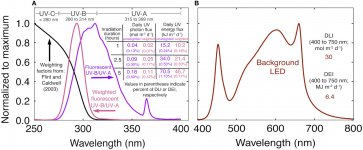UV-B has not shown any worthwhile benefit to cannabis from a handfull of recent studies. None.
So please help me spread the word: UV-B increasing THC is bullshit.

 www.frontiersin.org
www.frontiersin.org
So please help me spread the word: UV-B increasing THC is bullshit.
These data support recent literature and lead us to conclude that an elevated flux of UV photons is not an effective approach to increase cannabinoid concentration in high-cannabinoid cultivars.

Frontiers | Elevated UV photon fluxes minimally affected cannabinoid concentration in a high-CBD cultivar
Ultraviolet photons (UV) can damage critical biochemical processes. Plants synthesize photo-protective pigments that absorb UV to minimize damage. Cannabinoi...





